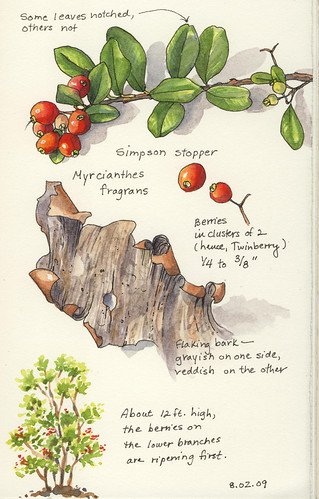Simpson’s or Simpson Stopper
Myrcianthes fragrans
Myrtle family
Simpson’s stopper forms a lovely compact small tree or large shrub in (mostly) full sun, which is where mine grows. It’s in fruit right now, heavy branches of berries in all stages from green to orange to red. The berries are said to be edible for humans, as well as favored by wildlife, especially mockingbirds. It’s also a nectar source for butterflies; the long white stamens make the flowers appear like tiny, frothy puffballs. Ethnobotany lore has it that the common name of stopper comes from the “stopping” powers of the leaves used in a treatment for diarrhea.
Simpson’s stopper has two other common names: twinberry and nakedwood. I assume the twinberry refers to the two-berry stems that I noticed on mine, and the nakedwood refers to the exfoliating bark habit. Nakedwood would be my favorite, but there is another Florida tree with the same common name and I dislike confusion. After reading more about the Simpson namesake, though, I’m convinced of its perfection. Charles Torrey Simpson was a self-taught botanist and malacologist (one who studies mollusks), and has been called “the father of all South Florida naturalists.” He first visited Florida in 1881, beginning a love affair with the state that lasted the rest of his life.
My botanical names book states that the genus Myrcianthes refers to the myrtle family. Fragrans is self explanatory: the flowers are quite fragrant and the leaves contain aromatic oils, some say reminiscent of nutmeg. My stopper smells just faintly fragrant, not quite nutmeg-like. It has numerous leathery and glossy medium-green leaves on somewhat stiff stems that range from copper-colored to brownish-gray. The peeling bark is similar to that of ornamental guava. With all of these wonderful traits, you might wonder why I planted it behind the house in a hidden corner. I do. Next time I’ll plant it where I can enjoy it every day!
Click on the image to go to my Flickr site to view larger.
~ Elizabeth Smith
Naples, Florida, USA


I just love your art and this is so informative. Great job.
ReplyDeleteI agree! I just love reading about the details of the tree and your art is so beautiful. I really enjoy seeing the close-ups of the bark, berries and leaves, and also seeing the thumbnail of the whole tree -- all on one page, too. Very nicely composed.
ReplyDeleteElizabeth, this was fascinating, thank you--your sketches are a delight! I'd never heard of this bush, or of Charles Torrey Simpson. This is a wonderful way to learn!
ReplyDeleteFabulous nature sketch and such interesting information. Thanks.
ReplyDeleteFascinating information and lovely observations!
ReplyDeleteThanks, everyone! I really appreciate your kind words. I learned a lot too - it's wonderful how the act of drawing or painting makes us look a little deeper.
ReplyDeleteWhat a great page! And I am off to learn about Charles Torrey Simpson. Thank you!
ReplyDelete